|
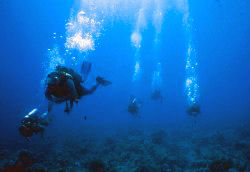 Most
reputable
dive companies will operate dive boats that are fully seaworthy
and are equipped with all the necessary safety and navigation
equipment, and carry comprehensive first aid and oxygen equipment.
(It is always worth checking). They should also employ
fully trained and competent personnel as dive guides and boat
crew. Most
reputable
dive companies will operate dive boats that are fully seaworthy
and are equipped with all the necessary safety and navigation
equipment, and carry comprehensive first aid and oxygen equipment.
(It is always worth checking). They should also employ
fully trained and competent personnel as dive guides and boat
crew.
All sports divers should make sure that their travel
insurance includes cover for scuba diving. Divers must be
covered for accidents which may occur during diving or as
a direct result of diving, recompression costs, hospitalisation
etc. and loss or damage to diving gear. The better dive companies
will offer specialist diving insurance.

Divers should be able to provide proof of medical fitness
should also take their 'C' Cards, Qualification Records or
other evidence of their diving qualifications for the Dive
Master or Guide to inspect.
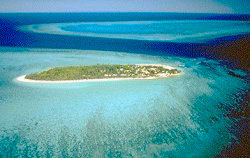 If
you are flying to your destination you will usually have
a baggage allowance of 20kg plus hand luggage. This can be
a problem since basic scuba gear weighs around 15Kg which
does not allow for much else. If you also carry underwater
photography equipment your allowance is quickly used up. For
this reason, cylinders and weights are usually provided on
site and equipment hire is also available. Sometimes divers
get an extra 10Kg per person "sports allowance" Check with
your agent. If
you are flying to your destination you will usually have
a baggage allowance of 20kg plus hand luggage. This can be
a problem since basic scuba gear weighs around 15Kg which
does not allow for much else. If you also carry underwater
photography equipment your allowance is quickly used up. For
this reason, cylinders and weights are usually provided on
site and equipment hire is also available. Sometimes divers
get an extra 10Kg per person "sports allowance" Check with
your agent.
Diving knives should always be packed with the rest
of your diving gear and carried in the hold, never in your
hand luggage. Pony bottles and emergency cylinders must be
completely emptied and also carried in the hold.
Many
divers travel abroad to dive on tropical coral reefs which
are one of nature's wonders. Nearly all coral reefs are in
the tropics which means that the local climate will be hot.
Divers must take care to avoid dehydration and desist from
sunbathing immediately following a dive since both are predisposing
factors in decompression illness.
Most
tropical dive locations are in and around developing countries
with poor standards of hygiene etc. Therefore, all the usual
travel precautions should be observed; i.e. vaccinations,
malaria tablets etc.
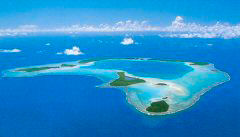 Because
of the repeated immersion in sea water, divers are prone
to ear problems. Infections can result from sea water trapped
inside the ear canal. Ears should be cleaned out with fresh
water after the last dive of the day and dried without poking
anything inside. Aluminium acetate ear drops are good for
drying out the ears. Because
of the repeated immersion in sea water, divers are prone
to ear problems. Infections can result from sea water trapped
inside the ear canal. Ears should be cleaned out with fresh
water after the last dive of the day and dried without poking
anything inside. Aluminium acetate ear drops are good for
drying out the ears.
After
several days diving a build up of mucus can lead to blockage
of the sinuses and Eustachian tubes giving rise to problems
during equalisation. Decongestants such as pseudoephedrine
are useful for treating this condition. One tablet should
be taken prior to the first dive of the day, the decongestant
effect will last up to eight hours.

| IMPORTANT
NOTE ON LARIAM (MEFLOQUINE) & SCUBA DIVING |
|
Lariam
(mefloquine) is an anti-malarial drug used in regions
of the world where chloroquine resistant falciparum
malaria is prevalent.
e.g. East Africa, South East Asia.
Possible side effects of Lariam such as dizziness, blurred
vision and a disturbed sense of balance are common and
could cause problems for divers.
These effects can often imitate or even worsen the symptoms
of DCI. There could also be confusion between the side
effects of Lariam and the symptoms of DCI or nitrogen
narcosis resulting in a misleading diagnosis.
Therefore, Lariam must not be taken by persons intending
to take part in scuba diving.
The manufacturers of Lariam recommend
that it should not be taken by persons who carry out
tasks demanding fine co-ordination and spatial discrimination,
including scuba diving. If Larium is taken, these persons
should refrain from such activities during and for at
least three weeks following use.
|
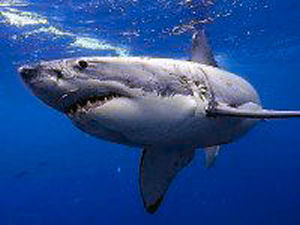 Dangerous
Marine
Creatures Dangerous
Marine
Creatures
Tropical
waters can sometimes give the impression of being alive
with dangerous creatures that can sting, bite, devour or otherwise
injure the unwary diver. Divers intending to dive in the tropics
should take time to familiarise themselves with the potentially
dangerous creatures they will be likely to encounter to reduce
the likelihood of injury from such creatures.
There is a general principle: if something is slow enough
for you to catch it or touch it - DONT!
Everybody's favourite villain is the shark. However,
most species of shark are completely harmless to man and even
if a potentially dangerous species is encountered it will
more often than not ignore the diver and swim away.
Most encounters with sharks are thrilling experiences
but when they are encountered during a dive they should always
be treated with the utmost respect and caution.
Remember
Sport Divers are probably at a greater risk from a travel
related illness than from diving-related accidents. |
| Potentially
Dangerous Sea Creatures |
|
-
Sea
Urchins - posses long brittle spines which contain
venom.
-
Cone
shells - have the ability to fire a toxic dart
into the victim.
-
Certain
species of octopus e.g. the Blue Ringed Octopus
is highly toxic.
-
Sea
Snakes - all of which are poisonous but will
not bite unless provoked a bitten person should
be evacuated to a hospital immediately.
The fatality rate is about 40%
-
 Stingrays
and Moray Eels - these are all harmless unless
molested. Stingrays
and Moray Eels - these are all harmless unless
molested.
-
Lionfish,
Scorpion fish & Stonefish - these are very
poisonous. They are usually brightly coloured or
camouflaged.
They possess spines which contain venom, contact
with which causes severe pain and sometimes even
death.
-
The
excruciating pain from the venom of scorpion
fish, lion fish etc. may be relieved by immersing
the limb in hot water,
the hotter the better (as hot as the victim can
stand).
-
Sea
urchin spines that become embedded may need
to be removed surgically.
- The
best form of treatment is avoidance.
For
much more information on Dangerous Marine Creatures:
|
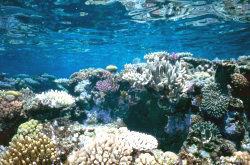 Coral
Reefs Coral
Reefs
Coral reefs are underwater
structures made from calcium carbonate
secreted by corals.
Coral reefs are unique structures built up over many
years. They flourish in the warm waters of the tropics, fringing
islands and continents, and forming atolls far out in the
ocean. Some are like beautiful gardens, paved with delicate
corals and home to innumerable brightly coloured fish. Others
are full of drama, with massive coral formations extending
into deep water with sharks patrolling along the reef edge.
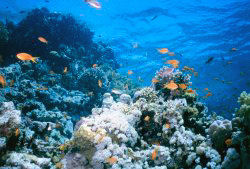 Corals
are made up of millions of tiny sea creatures called polyps.
Polyps are very closely related to the jellyfish and sea anemones
and like the anemones they possess tentacles for catching
their prey. They are colonial creatures with hundreds of polyps
in a single coral colony and they co-exist with algae in a
symbiotic union. Corals
are made up of millions of tiny sea creatures called polyps.
Polyps are very closely related to the jellyfish and sea anemones
and like the anemones they possess tentacles for catching
their prey. They are colonial creatures with hundreds of polyps
in a single coral colony and they co-exist with algae in a
symbiotic union.
Each polyp secretes an exoskeleton of chalk which forms the
basis of the reef and they are filter feeders catching tiny
food particles with their tentacles. The algae is able to
produce nutrients by photosynthesis and gives each coral its
distinctive colour.
Coral reefs are almost exclusively located in tropical seas.
This is because of the conditions required by the corals in
order to sustain growth. Which are:-
-
Bright
sunlight - to enable photosynthesis.
-
Warm water - optimal growth is between 24 - 32 deg.C
-
Clear
water - allows light penetration. Heavily silted water
will choke the corals.
-
Shallow
seas - sunlight cannot penetrate sufficiently below
100 metres to allow reef growth.
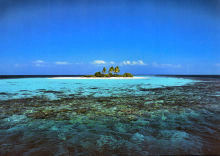 Corals
are normally found in marine waters containing few nutrients.
Most coral reefs are built from hard, stony corals, and are
formed by polyps that live together in groups. The polyps
secrete a hard carbonate exoskeleton which provides support
and protection for the body of each polyp. Reefs grow best
in warm, shallow, clear, sunny and agitated waters. Corals
are normally found in marine waters containing few nutrients.
Most coral reefs are built from hard, stony corals, and are
formed by polyps that live together in groups. The polyps
secrete a hard carbonate exoskeleton which provides support
and protection for the body of each polyp. Reefs grow best
in warm, shallow, clear, sunny and agitated waters.
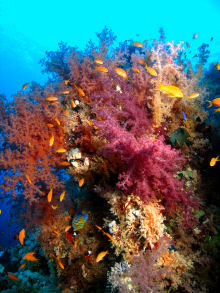 Often
called “rainforests of the sea”, coral reefs form
some of the most diverse ecosystems on earth. They occupy
less than 1% of the world ocean surface, about half the area
of France, yet they provide a home for 25% of all marine species,
including fishes, molluscs, echinoderms and sponges. Often
called “rainforests of the sea”, coral reefs form
some of the most diverse ecosystems on earth. They occupy
less than 1% of the world ocean surface, about half the area
of France, yet they provide a home for 25% of all marine species,
including fishes, molluscs, echinoderms and sponges.
Paradoxically, coral reefs flourish even though they are surrounded
by ocean waters that provide few nutrients.
They are most commonly found at shallow depths in tropical
waters, particularly in the Pacific Ocean, but deep water
and cold water corals exist on a much smaller scale.
Coral reefs deliver ecosystem services to tourism, fisheries
and shoreline protection. The annual global economic value
of coral reefs has been estimated at $30 billion. However,
coral reefs are fragile ecosystems, partly because they are
very sensitive to water temperature.
They are under threat from climate change, ocean acidification,
blast fishing, cyanide fishing for aquarium fish, overuse
of reef resources, and harmful land-use practices. High nutrient
levels such as those found in runoff from agricultural areas
can harm reefs by encouraging excess algae growth.
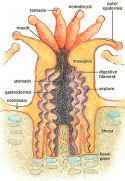 Live
coral should be thought of as small live animals embedded
in calcium carbonate. It is a mistake to think of coral as
plants or rocks. Coral consists of accumulations of individual
animals called polyps, arranged in diverse shapes. Polyps
are usually tiny, but they can range in size from a pinhead
to about a foot across. Reefs grow as polyps along with other
organisms deposit calcium carbonate, (the basis of coral),
as a skeletal structure beneath and around themselves, pushing
the coral's "head" or polyps upwards and outwards. Live
coral should be thought of as small live animals embedded
in calcium carbonate. It is a mistake to think of coral as
plants or rocks. Coral consists of accumulations of individual
animals called polyps, arranged in diverse shapes. Polyps
are usually tiny, but they can range in size from a pinhead
to about a foot across. Reefs grow as polyps along with other
organisms deposit calcium carbonate, (the basis of coral),
as a skeletal structure beneath and around themselves, pushing
the coral's "head" or polyps upwards and outwards.
Waves, grazing fish (such as parrotfish), sea urchins, sponges,
and other forces and organisms act as bio-eroders, breaking
down coral skeletons into fragments that settle into spaces
in the reef structure or form sandy bottoms in associated
reef lagoons.
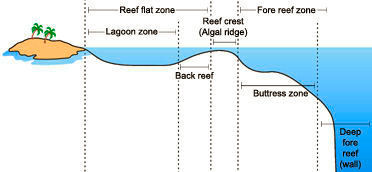 Many
other organisms living in the reef community contribute skeletal
calcium carbonate in the same manner. Many
other organisms living in the reef community contribute skeletal
calcium carbonate in the same manner.
Coralline algae are important contributors to reef structure
in those parts of the reef subjected to the greatest forces
by waves (such as the reef front facing the open ocean). These
algae deposit limestone in sheets over the reef surface, thereby
strengthening it.
Reef-building or hermatypic corals are only found in the photic
zone (above 50 m depth), the depth to which sufficient sunlight
penetrates the water for photosynthesis to occur. Coral polyps
do not photosynthesize, but have a symbiotic relationship
with single-celled organisms called zooxanthellae; these cells
within the tissues of the coral polyps carry out photosynthesis
and produce excess organic nutrients that are then used by
the coral polyps.
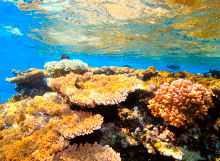 Because
of this relationship, coral reefs grow much faster in clear
water, which admits more sunlight. Indeed, the relationship
is responsible for coral reefs in the sense that without their
symbionts, coral growth would be too slow for the corals to
form impressive reef structures. Corals get up to 90% of their
nutrients from their zooxanthellae symbionts. Because
of this relationship, coral reefs grow much faster in clear
water, which admits more sunlight. Indeed, the relationship
is responsible for coral reefs in the sense that without their
symbionts, coral growth would be too slow for the corals to
form impressive reef structures. Corals get up to 90% of their
nutrients from their zooxanthellae symbionts.
Types of Coral Reefs
Most reef scientists generally recognize three basic types
of coral reefs:
-
Fringing
Reefs
-
Barrier
Reefs
-
Atolls

The differences
between these three main reef types are pronounced in terms
of large-scale structure. Nonetheless, there is often a good
deal of similarity between them within a given biogeographic
region in terms of species composition and ecological interactions.
1. Fringing Reefs
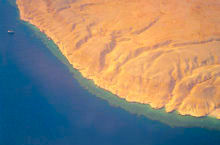 The
first major coral reef type is the fringing reef, which is
a reef system growing fairly close to or directly from shore
with an entirely shallow (less than about 10m) lagoon, or
no lagoon at all. The
first major coral reef type is the fringing reef, which is
a reef system growing fairly close to or directly from shore
with an entirely shallow (less than about 10m) lagoon, or
no lagoon at all.
These are by far the most common reef type in the Red Sea
and Greater Caribbean region. Fringing reefs also surround
many islands of French Polynesia (South Pacific) and the Indian
Ocean.
Many islands within atolls have fringing reefs often referred
to as the "house reef".
Patch Reefs are outcrops of coral usually offshore but often
found within the lagoon of a Barrier Reef or Atoll.
Because they are situated relatively close to island or mainland
shores, fringing reefs are generally the most susceptible
to coastal development, agriculture, pollution, and other
human activities that result in sedimentation and freshwater
runoff.
2. Barrier Reefs / Patch Reefs
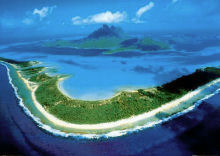 Barrier
reefs are reef systems that parallel the shore and are separated
from it by a wide lagoon that contain at least some deep portions.
Examples of large barrier reefs can be found in both the Indo-Pacific
and Greater Caribbean, with the Great Barrier Reef of Australia
being the prime example. Barrier
reefs are reef systems that parallel the shore and are separated
from it by a wide lagoon that contain at least some deep portions.
Examples of large barrier reefs can be found in both the Indo-Pacific
and Greater Caribbean, with the Great Barrier Reef of Australia
being the prime example.
The very largest barrier reefs develop on the edges of continental
shelves (e.g., Great Barrier Reef; Belize Barrier Reef). These
massive reef complexes are sometimes referred to as "shelf
barrier reefs" in order to differentiate them from the
much smaller barrier reefs surrounding some islands found
in the South Pacific (e.g, Bora-Bora).
The back reef zones and lagoons of shelf barrier reefs are
often very extensive, in some cases lying over 100 miles from
the mainland in some areas. In contrast, the barrier reef
surrounding the narrow lagoon of Bora Bora (photo, above right)
actually transitions into a fringing reef in a few places.
Patch reefs are similar to barrier reefs but they exist in
small patches or shoals rather than the huge structures formed
by barrier reefs.
3. Atolls
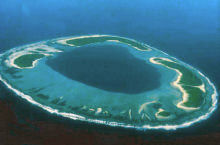 Atolls
are roughly circular (or occasionally horseshoe-shaped) oceanic
reef complexes surrounding a large, deep central lagoon. Atolls
are roughly circular (or occasionally horseshoe-shaped) oceanic
reef complexes surrounding a large, deep central lagoon.
Atolls are most common in the Indo-Pacific region where over
300 atolls are found, but rare in the Greater Caribbean which
houses only about 10-15. The four best developed Caribbean
atolls are found off southern Mexico and the coast of Belize.
Atolls can exceed 100 miles in diameter and contain lagoons
several thousand square miles in extent. The best developed
parts of reefs surrounding atolls are on the windward side,
where wave energy is greatest.
The Maldives is actually a nation comprised of atolls. Each
atoll has many islands on the outer rim and in some cases,
inside the atoll.
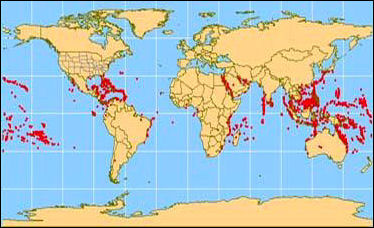
Map showing the distribution of the world's coral reefs
Reef
Divers
Sadly, like virtually every other natural habitat, coral
reefs are coming under intense pressure. Many have been polluted
and choked with sediment and rubbish washed from the land.
Others have been damaged by coastal development, coral mining,
over-fishing and collection of reef animals. Tourism too has
an impact, but YOU can help to minimise the damage.
-
Don't
touch corals, rest on them or kick them. Corals are living
animals and are damaged even by gentle handling.
-
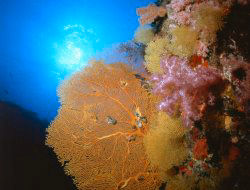 Avoid
kicking up the sand. It spoils the visibility for other
visitors and damages corals and other reef animals when
it settles. Avoid
kicking up the sand. It spoils the visibility for other
visitors and damages corals and other reef animals when
it settles.
-
Do
not spearfish. This is now prohibited in most countries
and spearguns are usually confiscated by Customs officials.
-
Leave
all corals and reef animals where they are. Corals are
the 'building bricks' of the reef. In many areas shells
and other reef animals have become rare because too many
people are taking them. Many tourist resorts and dive
operators ban collecting.
-
Make
sure you are properly weighted!
-
Take
great care in underwater caves and caverns. Avoid crowding
into a cave and don't spend too long there. Bubbles collect
in pockets on the roof of the cave and the delicate reef
animals there can 'drown in air'.
Boat
Owners
-
Should
never anchor on corals. They are easily broken or damaged
by anchors. Tie up to a mooring buoy or jetty, or anchor
carefully in sand or rubble patches.
-
Mind
the reef! Grounding is bad for your boat and the reef.
Navigation in reef waters needs special care.
Reef
Conservation
Nowadays more and more people are visiting coral reefs,
to look at their amazing variety of colourful life. Unfortunately,
all over the world reefs are suffering from too many visitors.
Corals that take years to grow are being damaged or destroyed
in an instant. Now is the time to act.
-
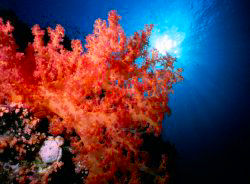 Encourage
efforts to protect reefs by visiting marine parks. Help
them to be a success by carefully obeying all the regulations. Encourage
efforts to protect reefs by visiting marine parks. Help
them to be a success by carefully obeying all the regulations.
-
Learn
more about reef and other marine life. Your visits will
be all the more enjoyable.
-
Be
satisfied with nature as it is. Fish feeding has a place
in selected areas but is best resisted elsewhere. It disrupts
natural behaviour and can upset the balance of species
on reefs.
-
Help
keep the reef clean. Always take your own litter away,
and also pick up other rubbish from the beach or reef.
-
Support
groups such as the Marine Conservation Society that are
involved in promoting the conservation of reefs.
- Follow
the visitors code. Take care of the reef not just for yourself,
but for all who follow.
|